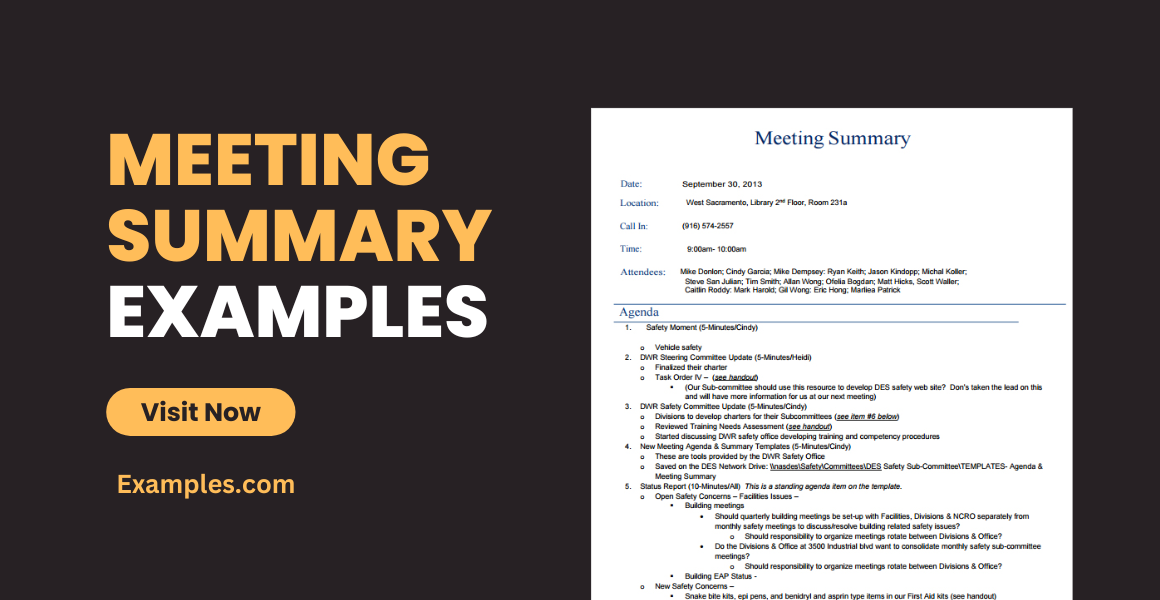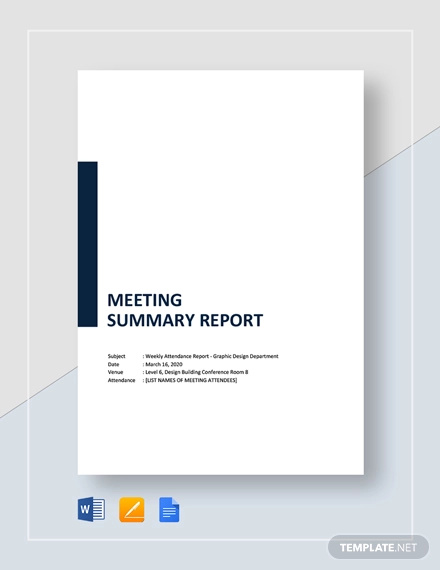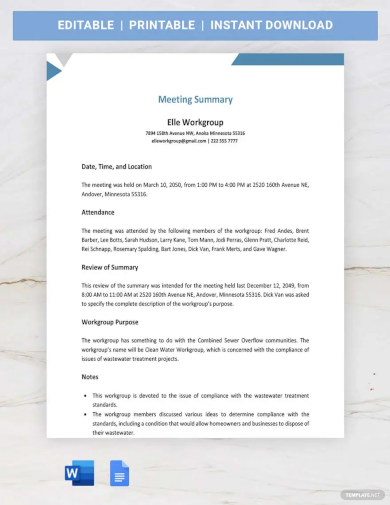Meeting Summary
Every company or organization conducts meetings to discuss certain topics, issues or development. There’s always a person who is tasked to take note of the key points that the meeting has discussed or achieved. And that person happens to be you. Whether you are the designated secretary or was asked to, making a summary of the meeting does not require too much hard work. However, there are certain formats that you need to follow so your summary is understandable and efficient. You may also see meeting outline examples & samples
Meeting summaries and minutes of the meeting are quite similar. It means summarizing the details of what the meeting has accomplished. The difference between the two documents is that meeting summaries are less formal compared to the minutes of the meeting. There is a format in minutes of the meeting that has to be followed precisely. However, for meeting summaries, it’s laxer in its format. But still, you need to put the correct information in both documents to avoid errors. You may also see meeting report examples & samples

What is the Importance of Having a Meeting Summary?
Having a meeting summary is for the people to remember the meeting and to keep track of the certain points that have already been discussed. It exists to record the highlights of the meeting proceedings such as the decisions that have been made (like motions, votes, etc.), plans for the future, identifying problems or issues and resolving them, reporting accomplishments of the company or organization for the past month or quarter, etc.
It is also used as a track record to see who are the people that participated in the meeting and as a source of information and reference for those who were absent during the meeting to know what tasks they were assigned to do and such. However, for this article, it will focus more on making a meeting summary than minutes of the meeting.
Now that you know why having a meeting summary is useful and important, let’s get down to business. Here are a few tips to help you write a meeting summary.
Before the meeting
When writing a summary, make sure you already know what will be the agenda of the meeting. If there will be the main agenda to accomplish, familiarize what are the important details or discussions to be tackled. Ask the one who presides the meeting if minutes of the meeting should be taken or not. If you need to, accomplish the minutes of the meeting first. You can get your reference for your summary from the minutes. Just make sure to prepare all the tools you need to take down notes for your summary:
- pen
- paper/notebook
- cassette recorder (if needed)
- documents needed in the meeting
- list of the people expected to attend the meeting
- copy of the agenda of the meeting (if applicable)
During the meeting
Meetings usually start when the group chair will formally announce that the meeting has started. Once the meeting has started, the first thing to accomplish is to do a roll call. Call out the names (from your list) of those who will participate in the meeting. Mark their names if they’re absent or present. If you have a copy of the past meeting summary with you, indicate the points that have been written down to remind the group of what topics they need to discuss that they were unable to do during the last one.
Once the agenda has been discussed, dedicate your 100% attention to the points that the participants said. Avoid any distractions. Even if you used a cassette recorder to record the meeting’s proceedings, it’s important to listen carefully to the meeting to avoid any confusion once you’ve listened to the recording later. There might be instances that the recordings will get lost or the sound is garbled, so don’t just solely rely on the recorder. Tape recorders are there to serve you as a back-up.
Aside from just listening, your role as making the meeting summary is to take down notes. Of course, you don’t necessarily need to list down everything that happened in the meeting (such as someone had a coughing fit or someone spilled their coffee on their clothes), but as mentioned above, list down the important key points that have been discussed.
List down the people who spoke up, who proposed ideas, who voice out their objections and agreements over a decision, the decisions that everyone has agreed to, the issues that have been resolved; that kind of thing. As much as possible, be objective in your note-taking. Don’t be shady over someone’s ideas or opinions that he or she expressed. Write down the ideas he or she proposed. If this seems confusing here’s an example of how to write it:
Graham suggested that the budget for improving the office’s facility should be spent on new chairs. Terry, Michael, and Carol agreed to his suggestion. However, Eric objected to this suggestion. Eric said to use the money to replace the old photocopier. John and Jones agreed to this. George, (the group chair) made everyone vote between the chairs and the photocopier. Graham’s suggestion won via unanimous decision.
Avoid writing this:
Graham suggested that the budget for improving the office’s facility should be spent on new chairs. (I agree with him. Our chairs are absolutely the worst. They need to be chucked out.) Michael, Terry, and Carol agreed. Just as everything is going well, snotty Eric opposed this idea passionately. He said the chairs are alright, it’s the photocopier that needs to be replaced. John and Jones murmured their agreement Graham and Eric then argued on which suggestion is better. George, the group chair, then let us vote on where should we spend the money. In the end, Graham’s suggestion won. Graham has a smug look on his face and Eric shut up, sulking.
Your notes will be your reference once you start writing your meeting summary later.
After the Meeting
After the meeting has adjourned, write down the meeting summary as soon as possible while the information from the meeting is still fresh in your mind. First, read and review the notes you have taken. If you were also tasked to write the minutes, review the and compare the information you wrote. If you want to be accurate with your information, review the meeting that you recorded. Identify the relevant themes in the meeting.
Meeting Summary Examples
Below are some format samples for you to follow if you want to be certain that your work is correct.
Meeting Summary Report
Meeting Summary Template
Meeting Summary Example
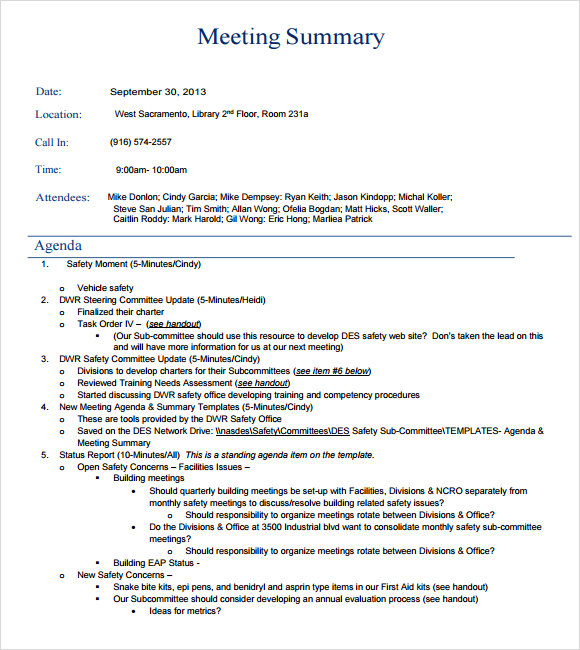
Source
How to Write a Meeting Summary
Now that you have gathered your notes for your summary, this is the part you need to organize your summary that you will pass to your group chair. This will make your summary neat and understandable.
- The meeting summary should be concise and summarizes perfectly the key points that have been discussed.
- First list down what is the main agenda of the meeting.
- List down the names of the people who attended the meeting. In another list below it, list down also who were not present in the meeting.
- Mention the date of the meeting, what time it started and what time it ended.
- Mention who is the group chair of the meeting. Mention how he or she presided the meeting. Mention also when he or she started the meeting.
- Mention what is the key points of the agenda that has been discussed first and second and third and so on. To organize the key points, list these down in bullet points or number them.
- In each key point, mention who opened up the topic first, their proposals and their decisions, who opposed and who agreed. List down the important points they mentioned.
- Write down also what are the new ideas the participants have come up with.
- Once the key points have been discussed thoroughly by the group, write down what was the final discussion of the group. What has the group agreed upon? What is the outcome?
- If the meeting has accomplished its agenda, write down the time of the adjournment.
- If there are any recommendations on what will be the agenda/topic/issues/ideas to discuss in the next meeting, list those down.
Once you’ve familiarized yourself with this format, it’s time to review the summary you wrote.
Evaluate if the Summary is Good
Once you’ve finished writing the meeting summary, review it first before passing it to the group chair for review and affirmation. Here are the important points to be considered once you’ve written down your summary:
- Make sure your reader will understand the important details in your summary especially those who were present in the meeting. To achieve this use particular words or jargon applicable in your summary. Make sure your co-workers will be able to understand what you wrote.
- Think if you succeed in the expectation of your reader while reading your summary. Not only they’ll be able to understand your summary, make sure they can use your summary as an important reference for future meetings or projects.
- If you’re not sure that your summary us concise and easy to understand to other people, have a friend to review it for you. He or she can help you out in the areas you need to improve.
By doing this, you avoid doing sloppy work over an easy task. You are confident that your meeting summary is good enough for everyone’s expectations. Your group chair may even praise you for a job well done. Your co-workers will trust you enough that you do a great job in your assigned task. Making meeting summaries are easy enough to achieve it once you know how to do it.
Meeting Notes Template Example
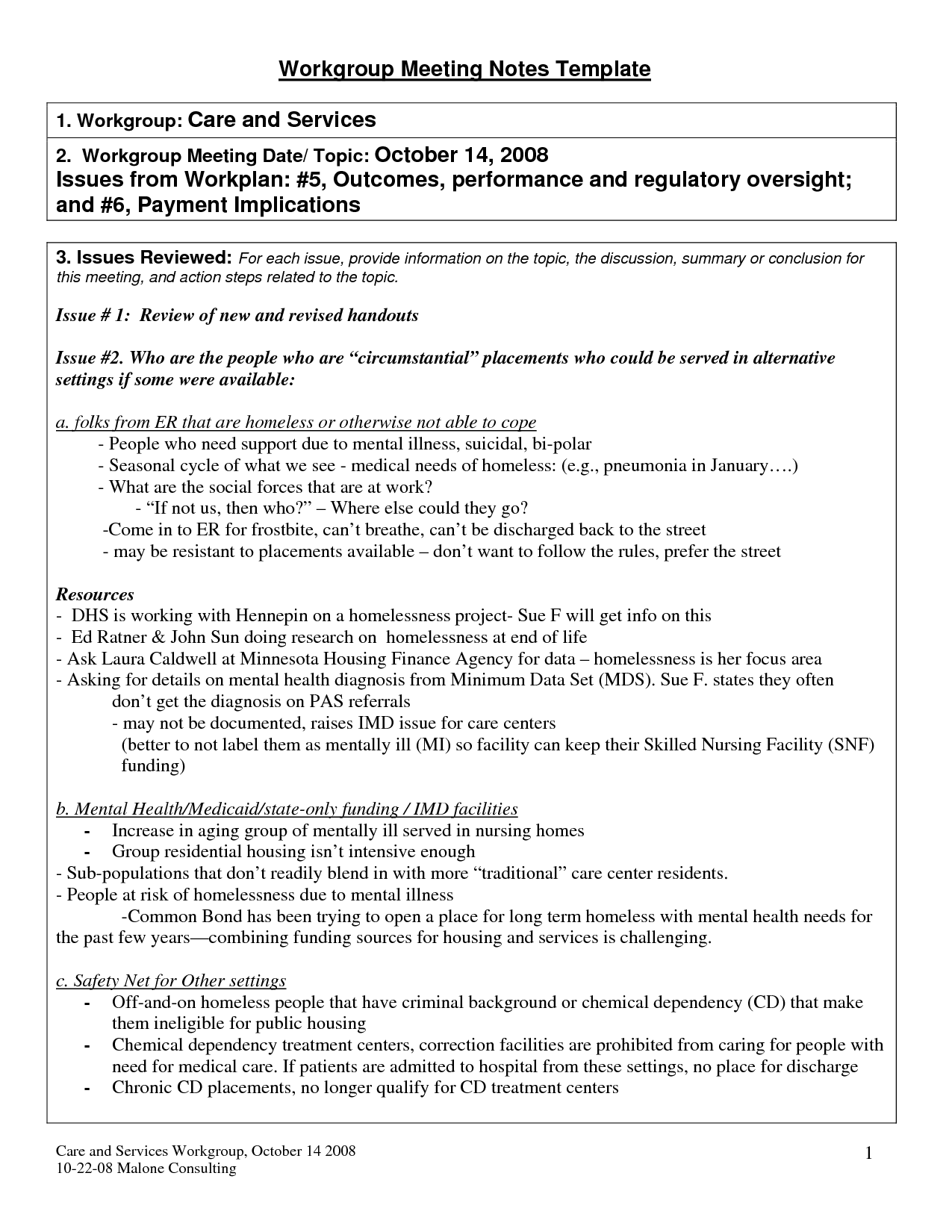
Source
Meeting Summary Example 3
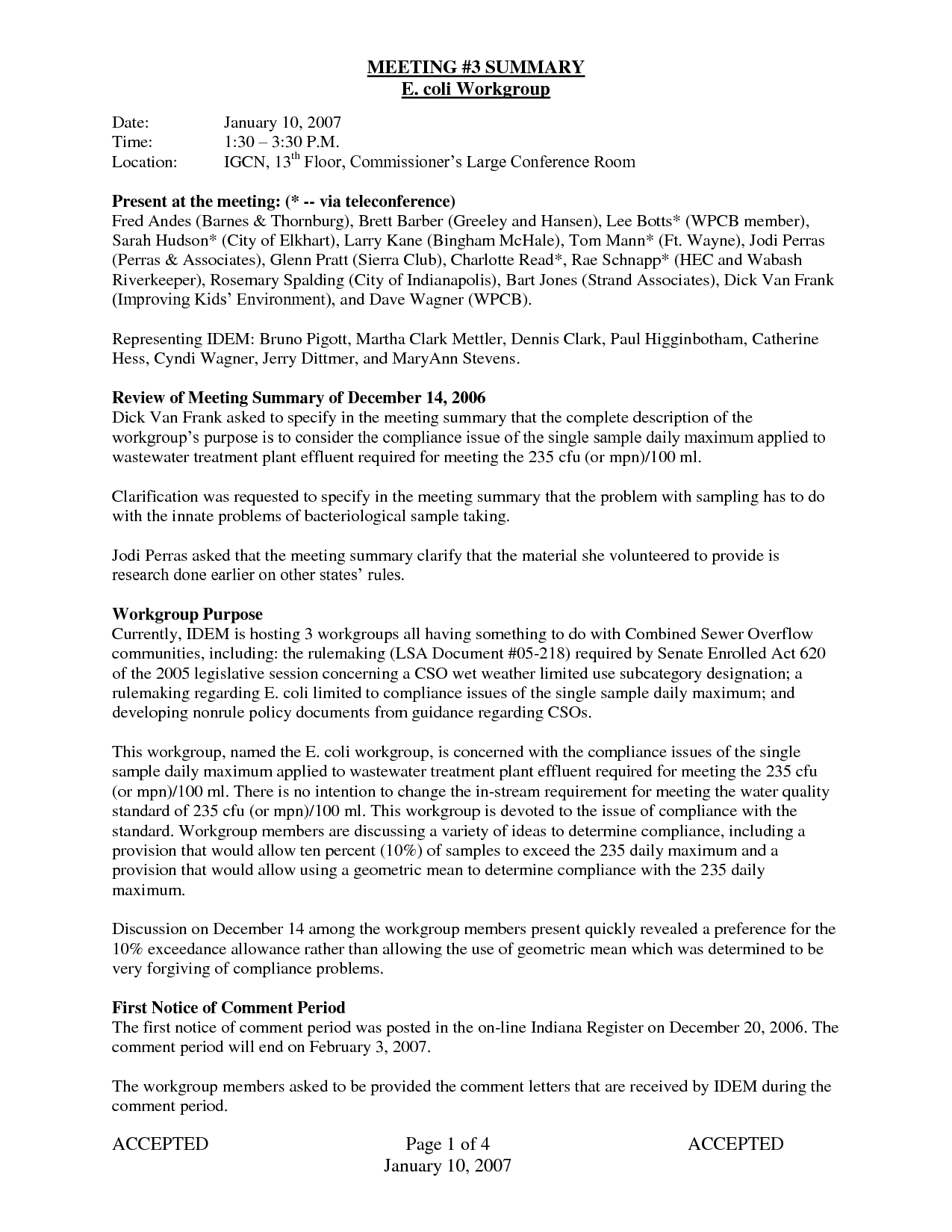
Source
We hope you found our article on meeting summary examples to be informative as well as helpful especially when you will be tasked on making a meeting summary for your own company.
General FAQs
1. What is a Meeting Summary?
A meeting summary is a document that provides information relating to an unofficial overview of a meeting. It records the decisions made, plans for the future, and the names of people who participated in the meeting.
2. How To Write a Meeting Summary?
You can write a meeting summary by following these guidelines:
- Discuss with your manager if the report should be detailed or just contain highlights.
- Analyze the meeting agenda in advance so you can get important details upfront.
- Make use of a template.
3. What is the Purpose of a Meeting Summary?
A meeting summary allows the writer to reflect on the discussions that have been made during the meeting. It also acts as a record of a meeting so that others can be informed of the discussions, either immediately or in the future.
4. What is the Difference Between Meeting Summaries and Meeting Minutes?
Meeting summaries are semi-formal documents that provide a less detailed and unofficial summary of a meeting. Whereas, meeting minutes are formal documents that provide a detailed record of a meeting.
5. How Can You Take Notes During Meetings?
You can take notes during meetings by following these points:
- Create an outline or use a template based on the agenda
- Check-off attendees
- Record decisions as soon as they occur
- Ask for clarification if necessary
- Capture only the highlights of the meetings
- Record it.


